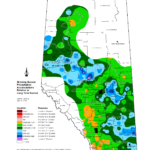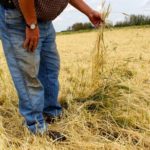Reading Time: 2 minutes Think about nitrate accumulation when salvaging cereal, oilseed, or hay crops damaged by hail, says a provincial beef and forage specialist. “Nitrate accumulation occurs in a plant when it is injured and is not able to convert nitrate to protein efficiently after a hailstorm,” said Barry Yaremcio. “In non-legume crops, water and nutrients are pushed […] Read more

Nitrate accumulation a danger in hailed-out crops
The crop, its development stage, and the amount of nitrogen in the soil all need to be considered

Most Alberta crops in good to excellent condition
Reading Time: < 1 minute Alberta Agriculture and Forestry has issued its latest crop report with conditions to July 19. This is an abbreviated version; click here for the full report and tables by region. With significant rains across the province, particularly in the South and Central Regions over the past two weeks, most of the agricultural lands in Alberta […] Read more

Salvaging hail-damaged crops
Reading Time: 2 minutes Storm damage to crops can result in problems with nitrate accumulations, especially if the crops were heavily fertilized or manured in the spring to optimize yield. “With volatile weather comes storm damage and, for some producers, this means salvaging crops for feed,” says Andrea Hanson, beef extension specialist, Alberta Agriculture and Forestry, Airdrie. Hanson cautions […] Read more
Stripe rust survey update for southern Alberta
Reading Time: < 1 minute This week, Dr. Denis Gaudet and his crew at AAFC-Lethbridge surveyed 23 spring wheat fields from Cardston to Vulcan for stripe rust. Stripe rust was seen in 50 per cent of the fields with the average incidence ranging from trace to 5 per cent. In three fields, incidences ranged from 15-90 per cent but severities […] Read more
“Exceptional” crop ratings in Alberta
Reading Time: < 1 minute Alberta Agriculture and Rural Development has released its biweekly crop report for July 24. The provincial summary follows. The full report is available alongside. Alberta has seen the return to more seasonal temperatures over the past several weeks following the hot weather experienced two weeks ago. Sporadic light and heavy showers were reported in all […] Read more
Beware of baling hay too early in hot weather
Reading Time: 2 minutes An Alberta Agriculture beef specialist warns that hay needs to be completely cured before being baled. Recent high temperatures, resulting in quick drying conditions, have some producers heading out to bale within two to four days after cutting. If hay isn’t completely cured, there could be damage to the hay after being baled. “Moisture probes […] Read more
First frost hits northern Alberta
Reading Time: < 1 minute Ralph Wright, soil moisture specialist with Alberta Agriculture, has released a map showing that overnight temperatures dipped below zero across two large areas on the night of Sept. 11-12 These areas are roughly centred around Edmonton and Grande Prairie. Several stations recorded overnight temperatures that dipped below 0 C, across two large areas; one centred […] Read more
Alberta encourages BSE sampling
Reading Time: < 1 minute Alberta Agriculture and Rural Development and the Canadian Food Inspection Agency are reminding cattle producers in Alberta to call their veterinarians to collect brain tissue samples to be tested for Bovine spongiform encephalopathy (BSE), also known as Mad Cow Disease. Cattle producers play a key role in monitoring and eradicating this disease from the Canadian […] Read more
Generally good Alberta conditions except for the Peace
Reading Time: 2 minutes Alberta Agriculture’s biweekly crop report indicates generally good conditions, except in the Peace River region, which continues dry. The report’s summary follows. For a full report including tables, click here. Precipitation received during the last two weeks varied considerably across the province. In the Peace Region, it was more than 20 mm in the northern […] Read more

